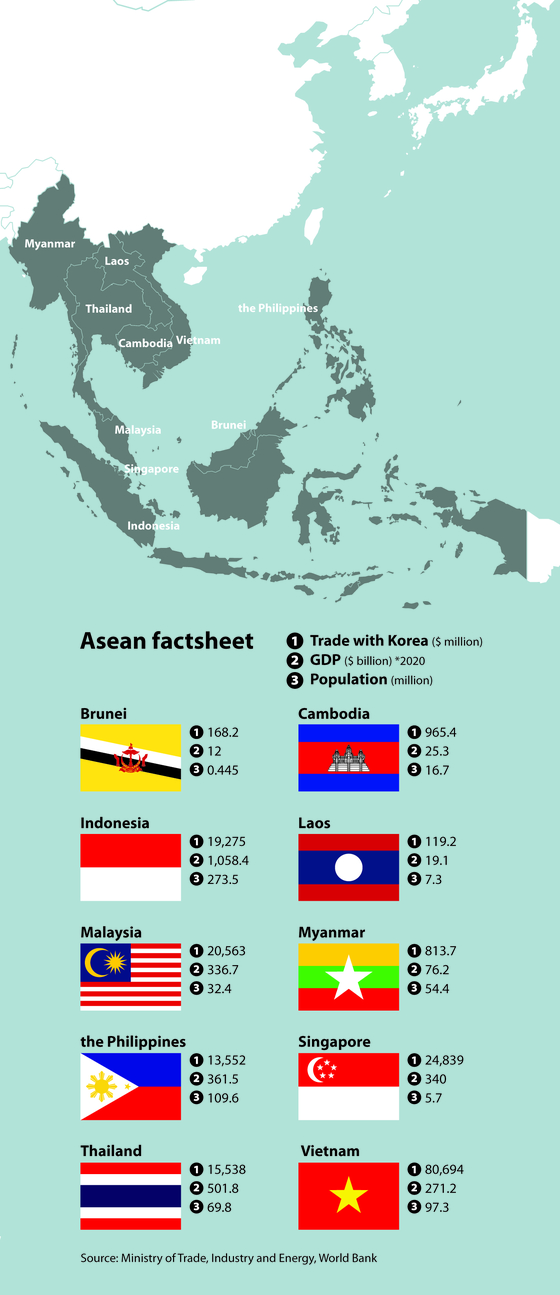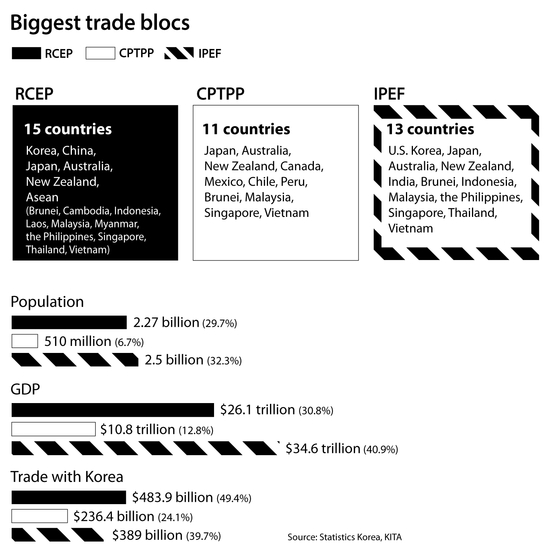As globalization ends, RCEP will help maintain trade order
![Export ships docked at a port in Busan. The global trade order has been changing rapidly, leaving Korea, which relies on trade, vulnerable. [YONHAP]](https://koreajoongangdaily.joins.com/data/photo/2022/05/23/daa78ccf-c1e5-4154-8551-877d9663fa81.jpg)
Export ships docked at a port in Busan. The global trade order has been changing rapidly, leaving Korea, which relies on trade, vulnerable. [YONHAP]
The Russia-Ukraine conflict has accelerated the geopolitical fragmentation and national-interest driven protectionist movements, which have fed inflation, which in turn further exacerbates protectionism.
Stuck between China and the United States — its two biggest trading partners — and dependent on exports for 70 percent of its GDP, Korea works to balance interests, hedge its bets and preserve its access to foreign markets. Already cut off from Russia — which was a small but growing opportunity for Korean companies — it is now making sure open economies remain open.
Korea has already been aggressive in its signing of free trade agreements (FTA). It continues to push for more FTAs to minimize disruptions that could occur as the global economy becomes more Balkanized. The next frontier is a series of agreements that are multilateral in nature and not strictly trade agreements.
The Regional Comprehensive Economic Partnership (RCEP) went into effect earlier this year, and Korea is now seeking to enter the smaller Comprehensive and Progressive Agreement for Trans-Pacific Partnership (CPTPP) and the U.S.-led Indo-Pacific Economic Framework (IPEF).
Multilaterally speaking
The RCEP went into effect in Korea on Feb. 1.
While the immediate effect of the RCEP is expected to be limited, it is seen cushioning the blow of global economic shifts and marginally increasing opportunities, especially with Asean countries.
The RCEP took eight years of negotiation and has a total of 15 countries signed on: Korea, China, Japan, the Asean 10 — Brunei, Cambodia, Indonesia, Laos, Malaysia, Myanmar, the Philippines, Singapore, Thailand and Vietnam — Australia and New Zealand.
The underlying agreement kicks in over 20 years and will eventually end tariffs on 91.5 percent of products on average.
Asean markets have agreed to lower tariffs on between 91.9 and 94.5 percent of Korea's key export items, including automobiles, steel and petrochemical goods. The current Korea-Asean FTA reduces tariffs on 79 percent to 89 percent of products.
With 15 members, the RCEP is one of the world's biggest multilateral trade pacts.
According to the UN Conference on Trade and Development (UNCTAD), the RCEP 15 generate 30.5 percent of the world's GDP, the United States–Mexico–Canada Agreement (USMCA) 28 percent and the EU 17.9 percent.
RCEP members have 2.3 billion people, one-third of the world's population, and intraregional trade between RCEP member countries as of 2019 was $2.3 trillion.
A study by the Korea Institute for International Economic Policy (KIEP) noted that the RCEP will contribute significantly to the region and the world's economy.
It estimated that by 2030, the deal will increase the income of members by 0.6 percent, adding $245 billion annually to regional incomes, and 2.8 million jobs to regional employment.
Trade is expected to grow at 2 to 3 times the rate of income growth.
This is not only because of its economic size but also the high degree of prior integration.
The research institute projects that there will be strong gains in trade and better integration of production lines and therefore increases in productivity.
Since the RCEP went into effect, the world has rapidly changed.
Russia's invasion of Ukraine has forced countries to start picking sides, and the sanctions and countermeasures applied are having a huge impact on the global trade order, already in shambles as a result of the Covid-19 pandemic.
In April, the World Trade Organization (WTO) slashed this year's global growth outlook from 4.7 percent to 3 percent citing the Russia-Ukraine war, the pandemic and China's lockdown.
That impact is expected to hit Korea's economic growth.
The Korea Development Institute (KDI) last week revised its growth outlook from 3 percent to 2.8 percent.
While inflation is a major concern, state-run KDI cited the slowing growth of Korea's export, especially in the second half.
"There is a need to utilize RCEP, which we are already a member of," said Kim Kyung-hoon, a Korea International Trade Association (KITA) researcher. "We also need to join the IPEF and the CPTPP and actively lead in forming a new trade order."
The researcher stressed that improving the resilience and stability of the supply chain network has become the goal of the government and private companies as risks related to the supply of goods and components have emerged and economic security becomes a top priority.
"If the reorganization of supply network, especially of technology alliances centered on the U.S., becomes real, there will be a major change in the current supply routes of high-tech intermediate goods," Kim said.
Shift in global value chain
The sudden emergence of Covid-19 has sped up the end of globalization as we know it, where some countries have benefited from low cost labor in other countries.
Korea fell into panic when China tightened urea exports, after it banned imports of coal from Australia as ties between Beijing and Canberra deteriorated. China was the biggest importer of Australian coal.
Restrictions on urea, which is extracted from coal, in return disrupted the supply of urea solution, which is essential to diesel-powered vehicles.
Truck transportation was nearly brought to a standstill, while construction and farming were also affected.
"As we have experienced through the urea solution crisis and the U.S. foreign-produced direct product rule, the role of commerce is becoming more important — the connections between different industrial products," said Chang Sang-sik, head of industrial analysis at KITA.
Countries not included in the bloc and left out of the regional value chain are expected to struggle to purchase a steady supply of commodities.
Resilience is now more important than efficiency, and national security is now ahead of corporate profit.
"As China is changing its role to a major consumer, Vietnam, India and Taiwan are emerging as new centers of production," said Ha Keon-hyeong, Shinhan Investment analyst. "Korea does not have a solid footing as a production center with greenfield investment shrinking and the regional value content less than 6 percent.
"Korea is one of the top in technology in Asia, so it is likely that the division of labor structure with Asean and India, which has a strong workforce, will be strengthened."

One of the key benefits of the RCEP is the strengthening of economic ties with Asean countries.
In 1990, the trade exchange between Korea and Asean was $8.2 billion. That trade was $176.6 billion last year. Asean, which only accounted for 8 percent of Korea's total trade now is around 15 percent.
Asean today is Korea's second-largest export market after China.
Last year Korea's exports to Asean totaled $108.9 billion, which is a 22.3 percent year-on-year increase. To China, they were $162.9 billion, up 22.9 percent.
Korea exported $95.8 billion to the United States, up 29.4 percent, and $646 billion to the EU, up 33.9 percent.
China takes 25 percent of all of Korea's exported goods, Asean 17 percent and the United States 15 percent.
Korea imported $138.6 billion of Chinese goods last year, up 27.3 percent, $73.2 billion of U.S. goods, up 27.3 percent, and $67.7 billion of Asean goods, up 23.4 percent.
Korea has been in pursuit of better ties with the Asean countries under the New Southern Policy.
The new policy paradigm, which is not only about economics but also diplomacy and culture, is targeted at increasing the relationship to the level of the neighboring powers — U.S. China, Japan and Russia.

Despite protests from Beijing, Korea formally joined the U.S.-led Indo-Pacific Economic Framework (IPEF). The IPEF is unlike other multilateral trade pacts.
Its purpose is not the free exchange of goods and services. Instead it is focused on forming a security alliance.
The IPEF has four pillars — fair and resilient trade; supply chain resilience, infrastructure and decarbonization; and tax and anti-corruption.
Keys to IPEF are the steady supply of computer chips and balancing the power of China.
Japan, Australia, New Zealand and Singapore have expressed interest in joining. Membership could expand to Asean countries.
The Korean government has noted that cooperative frameworks such as the IPEF will contribute to the national interest at a time when the global order is changing. It emphasized that the IPEF will help the country in purchasing key components.
It "could further stimulate the establishment of an early warning system," the government noted.
The grouping's formal start is set for November 2023 during the APEC summit.
Korea also wants to join the 11-member CPTPP, which accounts for 12.9 percent of the world's GDP and 15.3 percent of global trade. It has 6.7 percent of the world's population.
Prime Minister Han Duk-soo stressed the need for Korea to join the CPTPP during his confirmation hearing last month.
"We will be at a disadvantage if we are left out of the multilateral trade agreement," said Han, who was involved in the negotiations of the United States-Korea Free Trade Agreement.
"Until now, the Korean economy has benefited from the global value chain," said KDI economist Kim Hyun-wook. "It was an advantage for companies to expand into emerging countries that provided cheap labor and new markets.
"We are now in a situation where we have to shift our supply chain to advanced countries with the United States at the center."
Korea's dependency on trade
Despite efforts to shift to a more domestic-demand driven economy, trade is still vitally important to Korea.
This was clear during the pandemic, when a record $644.5 billion of exports were achieved. Imports were a record $615 billion. Trade contributed to the country's 4.0 percent economic growth in 2021.
Trade today accounts for roughly 70 percent of the nation's GDP, up from 50 percent in 1990, when Korea's market opened up and globalization started.
Korea has become especially dependent on China. Trade with that country grew from 0.9 percent in 1990 to 25 percent today.
Trade with the United States during that period fell to 14.5 percent from 30 percent. In 2011, before the free trade agreement went into effect, that number was 10.7 percent.
According to KITA, Korea's trade with the U.S. has grown from $100.8 billion in 2011, before the FTA was enacted, to $169.1 billion in 2021. Exports grew from $56.2 billion to $95.9 billion.
The U.S. free trade agreement "led to an increase in the number of jobs in manufacturing and higher wages," said Kang Gu-sang, Korea Institute for International Economic Policy researcher,
Since its first FTA was signed in 2004 with Chile, Korea has ratified 17 bilateral and multilateral trade deals with 57 countries, including the one with China, which went into effect in 2015.
A full 78 percent of Korea's trade is with countries with which it has agreements.
BY LEE HO-JEONG [lee.hojeong@joongang.co.kr]










with the Korea JoongAng Daily
To write comments, please log in to one of the accounts.
Standards Board Policy (0/250자)